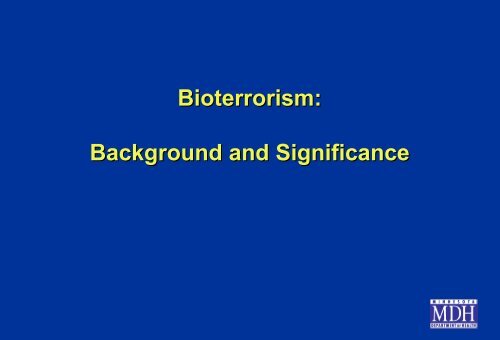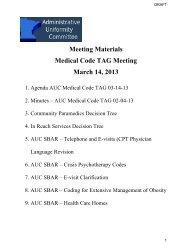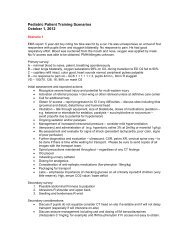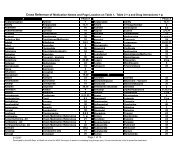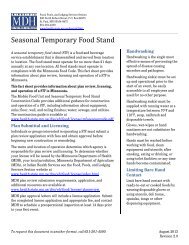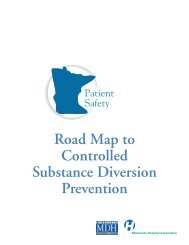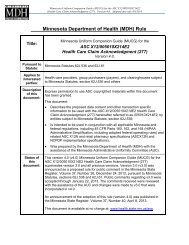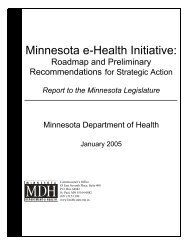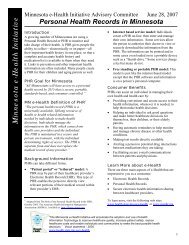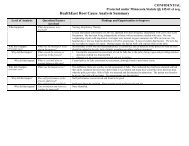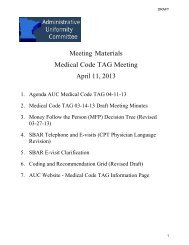Bioterrorism: Background and Significance - Minnesota Dept. of Health
Bioterrorism: Background and Significance - Minnesota Dept. of Health
Bioterrorism: Background and Significance - Minnesota Dept. of Health
Create successful ePaper yourself
Turn your PDF publications into a flip-book with our unique Google optimized e-Paper software.
<strong>Bioterrorism</strong>:<br />
<strong>Background</strong> <strong>and</strong> <strong>Significance</strong>
History <strong>of</strong> Biological Warfare<br />
• 1346 Siege <strong>of</strong> Kaffa; plague<br />
• 1763 French <strong>and</strong> Indian War; smallpox<br />
• WW I<br />
German program; anthrax, gl<strong>and</strong>ers<br />
• 1925 Geneva protocol bans biological<br />
weapons<br />
• WW II<br />
Japanese program; anthrax, plague,<br />
cholera, shigella
History <strong>of</strong> Biological Warfare (cont.)<br />
• 1941 George W. Merck named U.S. civilian<br />
head <strong>of</strong> Chemical Warfare Service<br />
later changed to War Research Service<br />
• 1946 U.S. announces its involvement in<br />
bioweapons research<br />
• 1969 Nixon eliminates <strong>of</strong>fensive biological<br />
warfare program
History <strong>of</strong> Biological Warfare (cont.)<br />
• 1972 Biological Weapons Convention<br />
• 1979 Accidental release <strong>of</strong> B. anthracis<br />
spores at bioweapons research<br />
center, Sverdlovsk, U.S.S.R<br />
• 1989-92<br />
92 Scientists from the former<br />
U.S.S.R. involved in biological<br />
weapons research defect to the West
Domestic Biological Terrorism<br />
• 1984 Rajneeshee cult members contaminate<br />
salad bar with Salmonella typhimurium in<br />
Oregon<br />
• 1992 Ricin attack planned by <strong>Minnesota</strong> militia<br />
• 2001 Anthrax releases in FL, DC, NY, NJ
Biological Terrorism<br />
• Use <strong>of</strong> biological agents to intentionally produce<br />
disease or intoxication in susceptible populations -<br />
humans, animals, or plants - to meet terrorist aims
Advantages <strong>of</strong> Biologics As Weapons<br />
• May be easier, faster to produce <strong>and</strong> more cost-effective<br />
than other weapons<br />
• Potential for dissemination over large geographic area<br />
• High morbidity <strong>and</strong> mortality<br />
• Creates panic<br />
• Person-to<br />
to-person transmission possible (smallpox,<br />
plague, <strong>and</strong> viral hemorrhagic fever)<br />
• Difficult to diagnose <strong>and</strong>/or treat
Ideal Characteristics for Potential<br />
Biological Terrorism Agent<br />
• Inexpensive <strong>and</strong> easy to produce<br />
• Can be aerosolized (1-10 10 µm)<br />
• Survives sunlight, drying, heat<br />
• Cause lethal or disabling disease<br />
• Person-to<br />
to-person transmission<br />
• No effective treatment or prophylaxis
Rajneeshee Cult, Salmonella - Oregon, 1984
MN Patriots Council, Douglas County, 1991
Sarin Gas Attack, Tokyo Subway, 1995
Operation Desert Storm
Ken Alibek - U.S.S.R. Program
Biological Agents Ranking System<br />
Public <strong>Health</strong> impact criteria based on:<br />
• Morbidity <strong>and</strong> mortality<br />
• Delivery potential<br />
• Public perception (fear, civil disruption)<br />
• Public health preparedness needs
Level A <strong>Bioterrorism</strong> Agents<br />
• Anthrax (Bacillus anthracis)<br />
• Smallpox (Variola major)<br />
• Plague (Yersinia pestis)<br />
• Botulism toxin (Clostridium botulinum)<br />
• Tularemia (Francisella tularensis)<br />
• Viral hemorrhagic fevers (VHF)
Other Potential <strong>Bioterrorism</strong> Agents<br />
• Brucellosis (Brucella species)<br />
• Gl<strong>and</strong>ers (Burkholderia mallei)<br />
• Q fever (Coxiella burnetii)<br />
• Cholera (Vibrio cholera)<br />
• Salmonella sp. <strong>and</strong> Shigella sp.<br />
• Venezuelan Equine Encephalitis (VEE)<br />
• Staphylococcal Enterotoxin B<br />
• Ricin (from castor beans)<br />
• T-2 Mycotoxins<br />
(Note that this is not a complete listing)
Estimated Casualties From a<br />
Hypothetical <strong>Bioterrorism</strong> Release*<br />
Agent<br />
Downwind Reach<br />
(km)<br />
Dead<br />
Sick**<br />
Rift Valley Fever<br />
Typhus<br />
Brucellosis<br />
Plague<br />
Q Fever<br />
Tularemia<br />
Anthrax<br />
1<br />
5<br />
10<br />
10<br />
>20<br />
>20<br />
>20<br />
100<br />
2,500<br />
150<br />
6,500<br />
50<br />
4,500<br />
24,000<br />
10,000<br />
30,000<br />
27,000<br />
27,000<br />
60,000<br />
60,000<br />
60,000<br />
*50 kg by aircraft, 2 km line upwind <strong>of</strong> a city <strong>of</strong> 500,000<br />
** Includes deaths
Investigation <strong>of</strong> Potential<br />
<strong>Bioterrorism</strong> Incident<br />
• Clinical<br />
• Epidemiology<br />
• Laboratory
Symptoms <strong>of</strong> Potential <strong>Bioterrorism</strong><br />
Diseases - Challenges <strong>of</strong> Detection<br />
Agent<br />
Anthrax<br />
Plague<br />
Q fever<br />
Tularemia<br />
Smallpox<br />
Clinical Effect<br />
Mediastinitis<br />
Pneumonia<br />
Pleuritis, hepatitis<br />
Pneumonia<br />
Pustules<br />
Initial<br />
Symptoms<br />
Headache<br />
Fever<br />
Malaise<br />
Cough
Biological Terrorism?<br />
Epidemiologic Clues<br />
• Tight cluster <strong>of</strong> cases<br />
• High infection rate<br />
• Unusual or localized geography<br />
• Unusual clinical presentation<br />
• Unusual time <strong>of</strong> year<br />
• Dead animals


